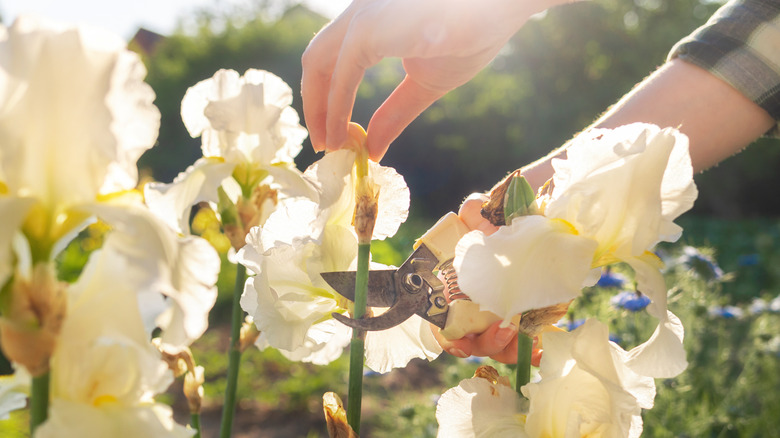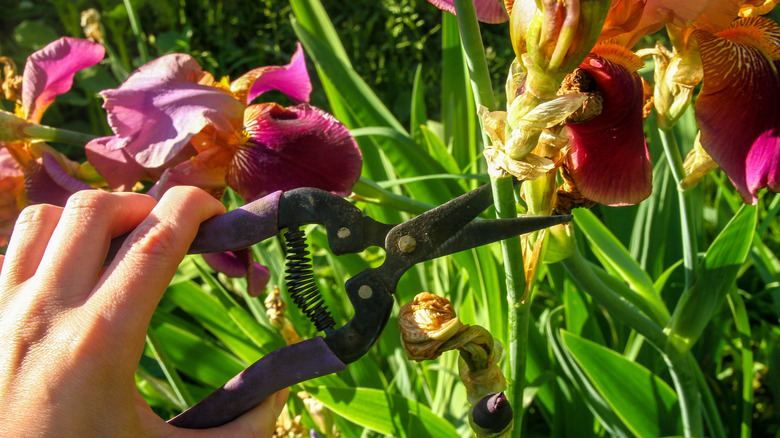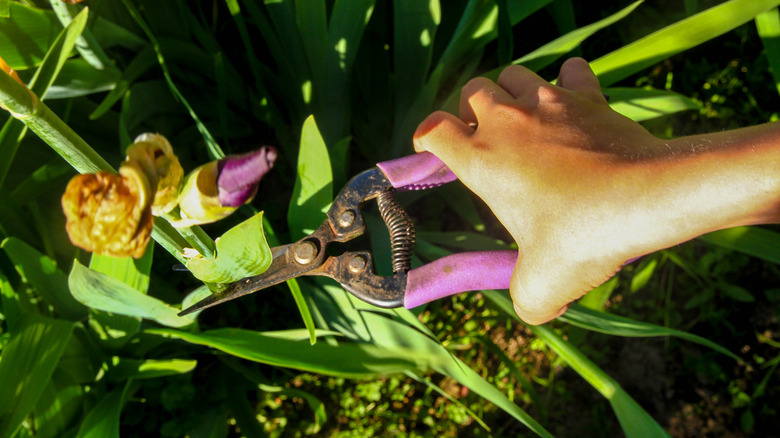How And When To Deadhead Your Irises After The Spring Bloom Period
Irises come in stunning varieties worthy of a spot in your garden and are a fantastic way to add pops of color to any landscape. They can bloom in a number of seasons, depending on which you choose. However, regardless of the varietal, proper deadheading will be essential to ensure healthy plants season after season. While the term deadheading may sound harsh, it simply means removing dead flowers from your irises in a timely manner. As David Cohen, the CEO of flower wholesaler Badais International, told Homes & Gardens, this is an essential task. "Deadheading an iris helps redirect the plant's energy from seed production to continued flower production," he explained. It also helps keep certain fungal diseases, like botrytis, at bay.
Once your irises begin to bloom, check them regularly so you can remove spent flowers as soon as you spot them or, at the latest, a couple of days after they've wilted. All you have to do is use sharp, clean pruning shears or scissors to cut the stem below the faded flower but above the healthy leaves. Just remember to double check you're not accidentally cutting off any hidden healthy buds along the way.
Choosing the right time to deadhead your irises
Irises are divided into three main types: the rhizome (beardless and bearded irises are easy to grow), bulb (smaller varietals like the Dutch Iris), and root varieties. When each iris actually blooms will depend on the individual variety, as well as on when you plant your iris bulbs. That, in turn, will impact the timing of your deadheading. If we look at some of the most common types of iris, the Tall Bearded Iris will flower between May and June, and the Dutch Iris will also show off its full colors in late spring. Meanwhile, some others, marketed as "rebloomers," will actually bloom twice, first in the spring, then in the early fall. When planting your garden, always take the time to note average blooming times for your chosen irises, so you'll know when you'll need to start deadheading.
The key, regardless of variety, is to remove flowers as soon as they are spent. This will allow the remaining plant and blooms to thrive. That's because, once flowers wilt, the plant begins growing seed pods to pollinate the next generation of irises – not only does this require a lot of energy, but some plants may actually bloom less in the future or die off completely after the seeding process. To avoid this, you want to stop the seeding process, and the way to do that is by removing the dead flowers so they can't give way to said seeds.
Deadheading irises vs. cutting them back for winter
If you've been vigilant about deadheading your irises, and their blooming season is coming to an end, you may think your work is done. Unfortunately, that's not the case. Once the blooming and pruning is over, you'll be left with a stem and leaves that will also naturally wither as winter approaches. Proper fall care will keep your irises healthy all year long, and that includes cutting back your irises. The ideal time to do this is just after the first frost has begun to kill off many of the leaves. This will make your irises strong enough to withstand the colder months and keep winter diseases at bay. What's more, cutting the foliage back once flowering has ceased helps the plant to store nutrients in its roots, getting ready for the next bloom. In order to properly cut back your irises, you'll again use your sharp, clean pruning shears or scissors, this time cutting the remaining stem 3 to 4 inches above the soil while making sure to leave any new sprouts untouched.
This is also the ideal time to split or divide any irises that have grown too close together. Rhizomes will actually reproduce continuously and will eventually become too clustered. When this happens, dig them up and replant as necessary (usually every 3 to 5 years) to ensure they're not competing with one another.


